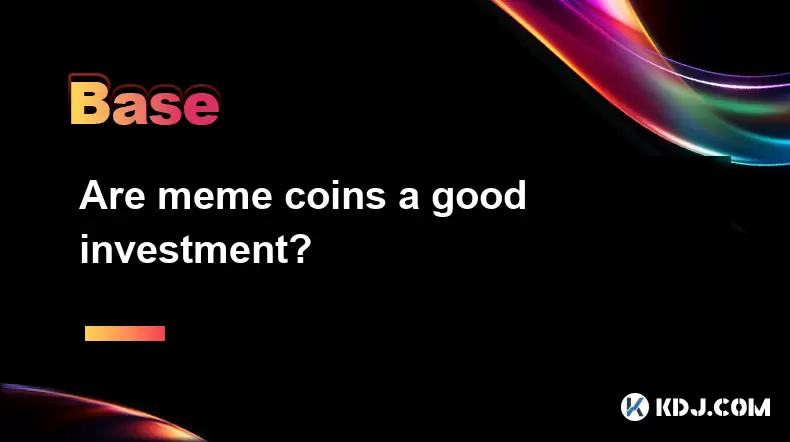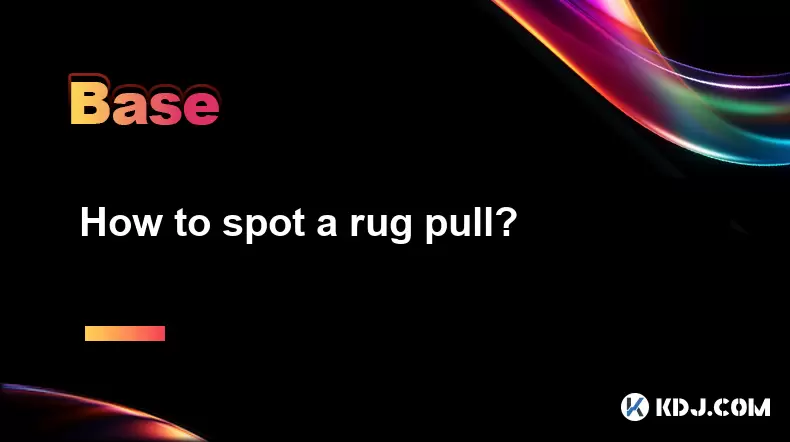-
 Bitcoin
Bitcoin $116700
0.24% -
 Ethereum
Ethereum $3973
4.34% -
 XRP
XRP $3.283
7.68% -
 Tether USDt
Tether USDt $1.000
0.01% -
 BNB
BNB $789.8
2.27% -
 Solana
Solana $176.2
3.31% -
 USDC
USDC $0.9999
0.00% -
 Dogecoin
Dogecoin $0.2238
5.14% -
 TRON
TRON $0.3389
-0.51% -
 Cardano
Cardano $0.7907
4.03% -
 Stellar
Stellar $0.4527
10.02% -
 Hyperliquid
Hyperliquid $41.07
4.27% -
 Sui
Sui $3.794
1.77% -
 Chainlink
Chainlink $19.49
10.40% -
 Bitcoin Cash
Bitcoin Cash $580.9
0.74% -
 Hedera
Hedera $0.2617
4.32% -
 Avalanche
Avalanche $23.41
3.67% -
 Ethena USDe
Ethena USDe $1.001
-0.03% -
 Litecoin
Litecoin $122.4
1.38% -
 Toncoin
Toncoin $3.364
1.49% -
 UNUS SED LEO
UNUS SED LEO $8.988
0.37% -
 Shiba Inu
Shiba Inu $0.00001295
2.82% -
 Uniswap
Uniswap $10.62
5.75% -
 Polkadot
Polkadot $3.922
4.46% -
 Dai
Dai $1.000
0.01% -
 Bitget Token
Bitget Token $4.494
2.15% -
 Monero
Monero $268.0
-1.30% -
 Cronos
Cronos $0.1523
3.68% -
 Pepe
Pepe $0.00001127
4.43% -
 Aave
Aave $285.4
4.85%
Are meme coins a good investment?
Meme coins like Dogecoin thrive on social media hype and community momentum, not technology, making them highly volatile and speculative investments.
Aug 08, 2025 at 11:36 pm

Understanding Meme Coins and Their Origins
Meme coins are a category of cryptocurrencies that originated from internet humor or viral trends rather than being developed for specific technological or financial use cases. The most well-known example is Dogecoin (DOGE), which began as a parody of Bitcoin in 2013 but eventually gained a substantial following. The appeal of meme coins often lies in their community-driven nature and the cultural momentum they gain through social media platforms like Reddit, Twitter, and TikTok. Unlike traditional cryptocurrencies such as Ethereum (ETH) or Bitcoin (BTC), which are built on utility and decentralized infrastructure, meme coins typically lack underlying technology or long-term development roadmaps. However, their rapid price movements and viral marketing strategies attract speculative investors seeking quick gains.
Volatility and Price Dynamics of Meme Coins
One of the defining characteristics of meme coins is their extreme price volatility. Prices can surge by hundreds or even thousands of percent in a matter of hours due to coordinated social media campaigns or celebrity endorsements. For instance, when high-profile figures like Elon Musk tweet about a particular meme coin, its value can spike dramatically. Conversely, the same factors can lead to equally rapid declines. This unpredictability makes meme coins highly speculative. Investors must understand that price movements are often detached from fundamental value and driven primarily by sentiment and hype. Trading platforms such as Binance, Coinbase, and KuCoin list popular meme coins, but their inclusion does not imply endorsement of their long-term viability.
How to Buy and Store Meme Coins Safely
Purchasing meme coins involves several critical steps to ensure security and authenticity.
- Create an account on a reputable cryptocurrency exchange that supports the desired meme coin.
- Complete identity verification (KYC) if required by the platform.
- Deposit funds using a supported method such as bank transfer, credit card, or stablecoin.
- Search for the meme coin using its ticker symbol (e.g., DOGE, SHIB, PEPE).
- Place a buy order at the current market price or set a limit order.
- After purchase, transfer the coins to a private wallet for enhanced security.
Using a hardware wallet like Ledger or Trezor is strongly recommended for long-term storage. These devices store private keys offline, protecting against online hacks. Software wallets such as Trust Wallet or MetaMask also support many meme coins, especially those on the Ethereum blockchain. Always verify contract addresses when interacting with decentralized exchanges (DEXs) like Uniswap, as fake tokens with similar names are common.
Risks Associated with Meme Coin Investments
Investing in meme coins carries substantial risks that go beyond typical market fluctuations. Many meme coins are created without audits or transparent development teams, increasing the likelihood of rug pulls—where developers abandon the project and withdraw all funds. Some tokens have inflated supply mechanisms or unfair distribution models that benefit early holders at the expense of later investors. Liquidity can also be a concern; low trading volume on decentralized exchanges may make it difficult to sell large holdings without significantly affecting the price. Additionally, regulatory scrutiny is increasing, and authorities such as the U.S. Securities and Exchange Commission (SEC) have warned that some meme coins may qualify as unregistered securities. This could lead to delistings or legal actions that impact value.
Community Influence and Social Media Hype
The success of a meme coin is often directly tied to the strength and activity of its community. Online forums and social media channels serve as hubs for organizing promotional campaigns, coordinating buys, and spreading memes that boost visibility. A vibrant community can create FOMO (fear of missing out), driving new investors to enter the market. Discord and Telegram groups are commonly used for real-time updates and announcements. However, this reliance on sentiment means that negative news or a loss of interest can cause prices to collapse just as quickly. Influencers play a pivotal role, and their endorsements can act as catalysts for price surges. It is essential to critically assess whether the hype is based on genuine growth or merely short-term manipulation.
Comparing Meme Coins to Utility-Based Cryptocurrencies
While meme coins capture headlines with dramatic price swings, utility-based cryptocurrencies serve functional roles within blockchain ecosystems. For example, Chainlink (LINK) enables smart contracts to interact with real-world data, and Polygon (MATIC) provides scaling solutions for Ethereum. These projects typically have whitepapers, development teams, and measurable adoption metrics. Meme coins rarely offer such transparency. Their value proposition is largely psychological and cultural rather than technical. Investors comparing the two should recognize that utility tokens may offer more sustainable long-term value, even if their price movements are less explosive. Evaluating a project’s codebase, GitHub activity, and on-chain metrics can help distinguish between speculative assets and those with foundational use cases.
Frequently Asked Questions
Can meme coins be mined like Bitcoin?
Most meme coins cannot be mined in the traditional sense. Dogecoin is an exception, using a Proof-of-Work consensus mechanism similar to Litecoin. However, the majority of meme coins, especially those on Ethereum, are pre-mined and distributed through liquidity pools, airdrops, or direct sales. Mining is not a viable method for acquiring newer meme tokens.
Are all meme coins scams?
Not all meme coins are scams, but many exhibit red flags such as anonymous teams, lack of code audits, or unrealistic promises. Projects with active development, open-source code, and community governance are less likely to be malicious. Due diligence is essential before investing.
How do I verify the authenticity of a meme coin?
Check the official website and social media for verified badges. Use blockchain explorers like Etherscan to review the smart contract, transaction history, and token distribution. Look for audits from firms like CertiK or Hacken, and avoid tokens with suspiciously large wallet concentrations.
What happens if a meme coin gets listed on a major exchange?
Listing on platforms like Binance or Coinbase can increase liquidity and visibility, often leading to a short-term price increase. However, this does not guarantee long-term success. Post-listing price action depends on sustained demand and market sentiment.
Disclaimer:info@kdj.com
The information provided is not trading advice. kdj.com does not assume any responsibility for any investments made based on the information provided in this article. Cryptocurrencies are highly volatile and it is highly recommended that you invest with caution after thorough research!
If you believe that the content used on this website infringes your copyright, please contact us immediately (info@kdj.com) and we will delete it promptly.
- Bitcoin, Litecoin, and Avalanche: Decoding the Crypto Buzz in the Big Apple
- 2025-08-09 00:30:12
- Pengu Takes Flight: Can This Solana Meme Coin Conquer the Top 3?
- 2025-08-09 00:50:13
- Coinbase's Big Bet: DEX Trading and the Everything App Vision
- 2025-08-09 01:30:12
- Ethereum and Shiba Inu: Navigating the Bull Move
- 2025-08-09 00:35:12
- Dogecoin, AI Coins, and CMC Listings: What's Hot and What's Not
- 2025-08-09 01:35:51
- Navigating the Crypto Market in 2025: Smart Decisions for Meme Coin Investing
- 2025-08-09 00:55:55
Related knowledge

Can you reuse a crypto wallet address?
Aug 08,2025 at 03:49pm
Understanding Wallet Addresses in CryptocurrencyA crypto wallet address is a unique identifier used to send and receive digital assets on a blockchain...

Are meme coins a good investment?
Aug 08,2025 at 11:36pm
Understanding Meme Coins and Their OriginsMeme coins are a category of cryptocurrencies that originated from internet humor or viral trends rather tha...

How are flash loans used?
Aug 08,2025 at 01:08pm
Understanding Flash Loans in Decentralized FinanceFlash loans are a unique innovation within the decentralized finance (DeFi) ecosystem, allowing user...

How to spot a rug pull?
Aug 08,2025 at 11:21pm
Understanding the Concept of a Rug PullA rug pull is a type of scam prevalent in the decentralized finance (DeFi) and cryptocurrency space where devel...

What is the environmental impact of crypto mining?
Aug 09,2025 at 12:28am
Energy Consumption of Cryptocurrency MiningThe environmental impact of crypto mining begins with its substantial energy consumption, primarily driven ...

What are common crypto trading strategies?
Aug 08,2025 at 12:42pm
Understanding Trend Following in Crypto TradingTrend following is one of the most widely adopted crypto trading strategies due to its simplicity and a...

Can you reuse a crypto wallet address?
Aug 08,2025 at 03:49pm
Understanding Wallet Addresses in CryptocurrencyA crypto wallet address is a unique identifier used to send and receive digital assets on a blockchain...

Are meme coins a good investment?
Aug 08,2025 at 11:36pm
Understanding Meme Coins and Their OriginsMeme coins are a category of cryptocurrencies that originated from internet humor or viral trends rather tha...

How are flash loans used?
Aug 08,2025 at 01:08pm
Understanding Flash Loans in Decentralized FinanceFlash loans are a unique innovation within the decentralized finance (DeFi) ecosystem, allowing user...

How to spot a rug pull?
Aug 08,2025 at 11:21pm
Understanding the Concept of a Rug PullA rug pull is a type of scam prevalent in the decentralized finance (DeFi) and cryptocurrency space where devel...

What is the environmental impact of crypto mining?
Aug 09,2025 at 12:28am
Energy Consumption of Cryptocurrency MiningThe environmental impact of crypto mining begins with its substantial energy consumption, primarily driven ...

What are common crypto trading strategies?
Aug 08,2025 at 12:42pm
Understanding Trend Following in Crypto TradingTrend following is one of the most widely adopted crypto trading strategies due to its simplicity and a...
See all articles

























































































